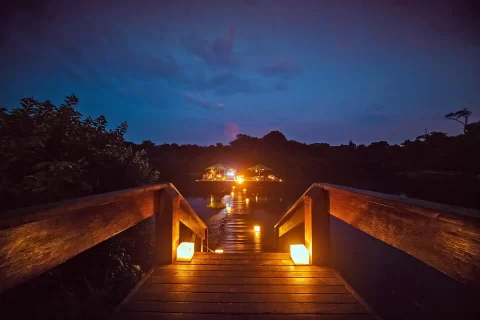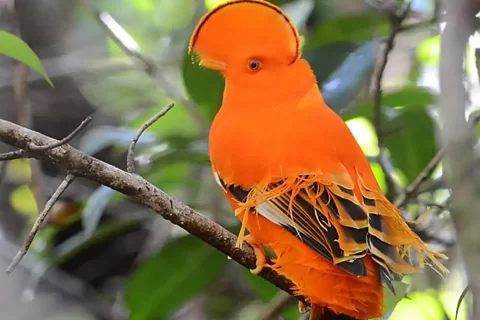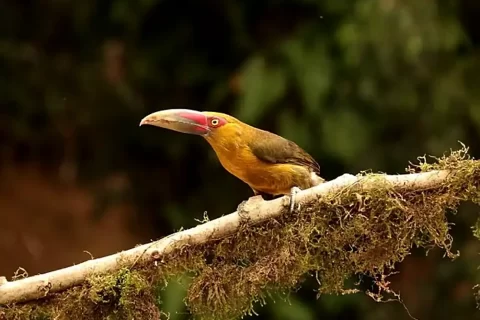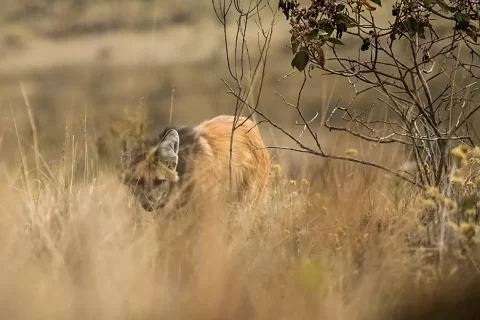Best time of year:
Any time
Duration:
8 – 11 days
Difficulty:
Fairly easy with long mornings in the field. Hot and humid climate.
Accommodations:
Very good to excellent.
Starts in and Ends in:
Alta Floresta
Tour Overview
Our signature trip is a two-week Amazonian extravaganza in the Southern Amazon region out of the town of Alta Floresta (where the Agami Nature Tours office is located) in the north of Mato Grosso state. No other operator offers such an extensive trip in the Southern Amazon. The typical visit of just a few days tends to just scratch the surface, and most visitors end up only staying at a single site in the region. Our Southern Amazon tour spends an introductory day in Alta Floresta to get our feet wet with parrots, toucans, and riverine forest specialties, 4 nights at the Rio Azul Jungle Lodge, home of the Bald Parrot and many white-sand specialists, and 5 nights at the world famous Cristalino Lodge, with its two canopy towers, 20+ kilometres of forest trails, and a bird list of more than 580 species. A great tour for specialties of the Southern Amazon such as Cryptic Forest-Falcon, Blue-cheeked Jacamar, Bare-eyed Antbird, Snow-capped Manakin and more. There are good chances for Harpy Eagle on this tour. Please enquire with us prior to the trip about the possibility of visiting an active Harpy Eagle nest in the region, as this is an alteration we are able to make at times. This is also an excellent tour for mammals, with good chances for Brazilian Tapir in addition to endemic primates such as White-faced Spider Monkey and the White-nosed Bearded Saki. The food and accommodations throughout this tour are excellent.
Itinerary
Day 1: Arrival in Alta Floresta.
The tour begins in Alta Floresta, a town in the southern Amazon region of the state of Mato Grosso. Alta Floresta is reached by a daily flight from Cuiabá, the state capital. Upon arrival in Alta Floresta in the early afternoon, you will be met at the airport by your guide for the short transfer to a comfortable birding lodge just outside of town, where a light lunch will be waiting for us. Once the hottest part of the afternoon passes, we can bird the grounds of our lodge Fazenda Anacã. The lodge is part of a novel project which combines a preservation ethos and sustainable farming practices as integral parts of its operation as a new birdwatching destination in the region. The palm swamps and gallery forests near the lodge are good for Blue-and-yellow and Red-bellied Macaws, Point-tailed Palmcreeper, and Blue-necked Tanager. After dinner we can do some owling on the hotel property to look for Tawny-bellied Screech-Owl, Crested Owl and Great Potoo.
Night at Fazenda Anacã.
Day 2: Morning around Alta Floresta. Afternoon transfer to Rio Azul Jungle Lodge.
Fazenda Anacã has developed partnerships with local landowners to help provide an economic alternative to logging and clearing forest for agriculture through ecotourism. The birding on these partner properties is excellent, and makes for a wonderful introduction to the birds of the southern Amazon. Trails and quiet tracks through tall terra firmeforest laden with vine tangles are home to specialties such as Paradise Jacamar, Eastern Striolated Puffbird, Black-chested Tyrant and Rose-breasted Chat, in addition to widespread but delightful species including White-throated Toucan, Scarlet Macaw, and Rufous-bellied Euphonia. After lunch at Fazenda Anacã we undertake the transfer to the Rio Azul Jungle Lodge, which should take roughly three hours in 4×4 vehicles over rough ranch roads. The drive is mostly through open country where we may see Pearl Kite and White-tailed Hawk, and through remnant forest patches where stops to stretch our legs might turn up some widespread Amazonian forest birds. We arrive to the Rio Azul in the late afternoon, just in time to unpack our suitcases and settle in for a four night stay at this really lovely family run lodge.
Night at Rio Azul Jungle Lodge.
Day 3 – 5: Rio Azul Jungle Lodge.
We have three full days to bird the Rio Azul. Originally opened as a fishing lodge, the lodge has been receiving birders since 2007, when Agami Nature Tours first discovered the locale as an important site for a number of rare specialty species. The foremost of these species is the recently-discovered (2002) endemic, the Bald Parrot. This compelling species is as grotesquely beautiful as its name suggests. We’ll be patrolling the river and other favourite haunts of the parrot in our quest to see for ourselves its featherless orange head, but in the process won’t be able to ignore a bevy of Amazonian beauties like Sunbittern, Crimson Topaz, and Red-throated Piping-Guan. We’ll bird trails in the riverine forests in search of Flame-crowned Manakin, Chestnut-belted Gnateater of the aurita race, Klage’s Gnatcatcher and Fulvous-crested Tanager. Antbirds abound here, and Yellow-browed, Spix’s Warbling, Black-faced and Dot-backed Antbirds should all be expected. Birding around the lodge itself is often quite fruitful – the natural hummingbird garden created by planting native flowering bushes is active year-round: the usual suspects include Green-tailed Goldenthroat, Fork-tailed Woodnymph, Black-eared Fairy, and Tapajos Hermit, while seasonal visitors include Black-bellied Thorntail and Amethyst Woodstar. The addition of hummingbird feeders has also revealed the presence of shyer forest species such as Gould’s Jewelfront and Straight-billed Hermit. In 2021 the lodge completed construction of a sturdy wooden tower in the middle of the lodge clearing, getting us closer to the local canopy birds such as White-browed Hawk, Brown-banded Puffbird, Blue-and-yellow Macaw, and a variety of tanagers including Masked, Blue-necked, Opal-rumped, Dotted, Black-faced and even White-bellied Dacnis has shown up here. We will also spend plenty of time birding the entrance road to the lodge, where a stunted white sand forest holds a unique avifauna including Bronzy Jacamar, Natterer’s Slaty-Antshrike, White-fringed Antwren, Pale-bellied Mourner, Black Manakin and Spotted Puffbird. Beyond the entrance track in the neighbouring cattle ranches, we find incredible concentrations of parrots, with six macaw species including Hyacinth Macaw. The diversity at the Rio Azul is amazing, the birding is excellent, and yet a visit to this lodge is usually fondly remembered for its intimate nature, the personalized attention and above all, the amazing food and sinful desserts.
Nights at Rio Azul Jungle Lodge.
Day 6: Travel to Cristalino Lodge.
We have a final morning at the Rio Azul to track down any target species we may not expect at Cristalino. After a farewell lunch we leave the lodge to make the drive back toward Alta Floresta, stopping alongside the broad Teles Pires river. Here we will be met by a Cristalino’s motor boats for the half hour transfer to Cristalino Lodge. It will be quite late in the afternoon by now, and we should see plenty of wildlife on the short trip upstream to the lodge: birds should include the striking Capped Heron, pairs of Bat Falcons, and perhaps even Razor-billed Curassow.
Night at Cristalino Lodge.
Day 7 – 10: Cristalino Lodge.
There is little doubt that the Cristalino Lodge is the finest birding destination in the Brazilian Amazon. With more than 20 kilometres of well-maintained trails, an uninhabited river, experienced and attentive staff, and two 50-metre canopy towers, it is nearly as an afterthought that we mention its bird list of more than 570 species. With four full days to explore the area, we’ll have time to visit the key birding sites. The showpiece observation towers provide great views over the canopy and give us good chances of seeing coveted species such as Curl-crested Araçari, Yellow-shouldered Grosbeak, Pompadour and Spangled Cotinga along with White-bellied and Red-fan Parrot. Eye-level flyby views of Blue-and-yellow and Scarlet Macaws are common. The extensive trail system at the lodge provides the birder with access to bamboo and vine-rich terra firme forest with sought-after species like Curve-billed (Tapajós) Scythebill, Manu Antbird and Rufous-capped Nunlet. Other trails take us atop a pair of granitic domes with more semi-deciduous forest and killer views of the surrounding canopy where we may find Pied and Brown-banded Puffbirds. Vast terra firme forests shelter leaftossers in their understorey haunts and are loaded with antbirds like Spot-backed, White-browed, Black-faced, Bare-eyed, and more. An active antswarm in the right place could be attended by Black-spotted Bare-eyes, Spix’s Guans and perhaps even a band of the endemic Dark-winged Trumpeter. We’ll visit known leks to look for Snow-capped and Red-headed Manakins, and at certain times of year an Amazonian Umbrellabird lek can also be visited. The list of avian attractions goes on and on; there will be plenty of birds to keep us busy every minute. On the mammal front we can expect to find several species of primates, most likely including the endemic White-faced Spider Monkey and Tufted Capuchins, along with Red-handed Howlers and the ‘fancy’ White-nosed Bearded Saki. The end of the dry season (September into October) is the best time of year to find Brazilian Tapirs at Cristalino, as they come to the river edges to cool off in the late afternoons. During a ‘good tapir year’ it is not uncommon to find multiple adults during a single afternoon boat trip up the Cristalino!
Nights at Cristalino Lodge.
Day 11: Return to Alta Floresta and outbound flight.
There is time for a final couple of hours of birding before we depart from the lodge in mid-morning. We return to Alta Floresta for a final farewell lunch before the group embarks on the early afternoon flight to Cuiabá, where you can either overnight or link up with outbound domestic flights.
End of tour.
Possible Extensions and Additions
Harpy Eagle Nests
Thanks to an impressive effort made by a tour operator specialized in finding rare and charismatic wildlife, more than two dozen Harpy Eagle nests have been discovered in the northern reaches of Mato Grosso state. Many of these nests are located within just a few hours of Alta Floresta; depending on which nests are active in any given year, we should be able to organize short Harpy Eagle extensions to a birding tour visiting the Southern Amazon. Please contact us for further details.
Juruena National Park
Encompassing nearly 2 million hectares (4.8 million acres), the Juruena National Park protects some of the most impressive Amazonian rainforest in the Southern Amazon. Agami Nature Tours is proud to offer pioneering itineraries to two different regions of the park: the southern reaches of the National Park harbour pristine primary forest where we bird mostly along a well-maintained grid of research trails; the northern part of the National Park has a greater variety of habitats, but in an area that has been occupied by humans for generations, meaning wildlife is a bit shier and forests have suffered disturbance in the past. In the southern end of the park we can visit the spectacular Salto Augusto waterfall, a locale of remarkable beauty and cultural importance.
















